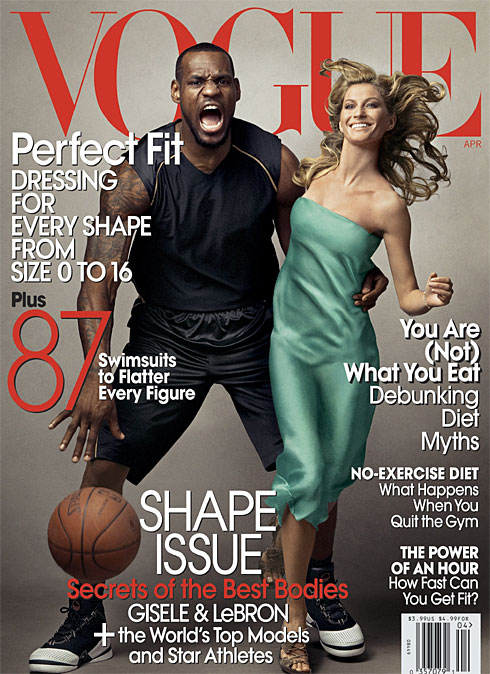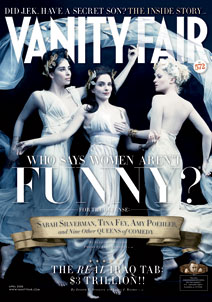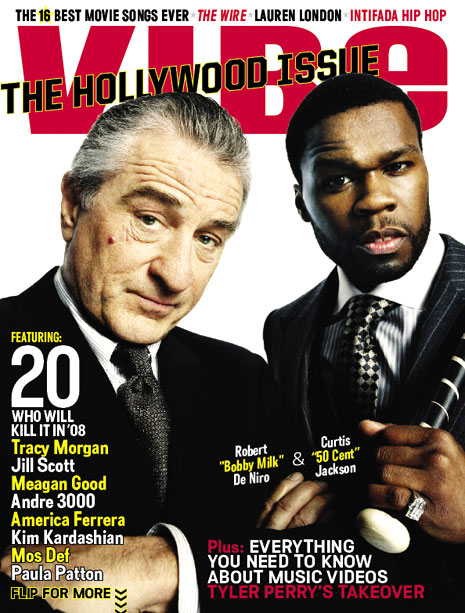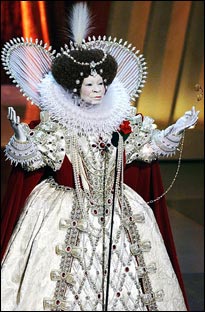Overdue congratulations to The Queen, Angela Bassett, for receiving a star on the Hollywood Walk of Fame this past Thursday.
Educate and excite, inform and infuriate.
March 25th, 2008 — Entertainment, Film, Pop Culture, Race
Overdue congratulations to The Queen, Angela Bassett, for receiving a star on the Hollywood Walk of Fame this past Thursday.
March 20th, 2008 — Culture, Magazines, Media, Race

For weeks, I’ve been trying to get the word out on an underreported paper by psychologists at Stanford, Pennsylvania State University and the University of California-Berkeley: According to these researchers, many Americans subconsciously associate Black people with apes.
In addition, the findings show that society is more likely to condone violence against Black criminal suspects as a result of its broader inability to accept African Americans as fully human, according to the researchers.
Those findings, researched over a six-year period, were printed February 7 in the Journal of Personality and Social Psychology, published by the American Psychological Association.
Co-author Jennifer Eberhardt, a Stanford associate professor of psychology who is Black, said she was shocked by the results, particularly since they involved subjects born after Jim Crow and the civil rights movement. “This was actually some of the most depressing work I have done,” she said. “This shook me up. You have suspicions when you do the work—intuitions—you have a hunch. But it was hard to prepare for how strong [the Black-ape association] was—how we were able to pick it up every time.”
When colleague Ray Winbush forwarded me the LeBron James/Gisele Bündchen VOGUE cover, above, my first raw thought was that James looked bestial. They look like King Kong and Fay Wray. Is it just me? Am I just imagining this?
March 19th, 2008 — Controversy, Crime, Government, Obituary, Politics, Race, Terrorism
March 5th, 2008 — Crime, Magazines, Race
 Yesterday, I wrote about my respect-recoil relationship with Vanity Fair magazine, as I felt “love-hate” was too flat to shade the nuances of my feelings about the publication. As I said then, what I detest is its racial myopia; a close focus on stories by, and about, white people. This is something basic to American media, “normal,” in certain ways, but increasingly glaring, for many reasons, at this magazine.
Yesterday, I wrote about my respect-recoil relationship with Vanity Fair magazine, as I felt “love-hate” was too flat to shade the nuances of my feelings about the publication. As I said then, what I detest is its racial myopia; a close focus on stories by, and about, white people. This is something basic to American media, “normal,” in certain ways, but increasingly glaring, for many reasons, at this magazine.
So what do I respect about Vanity Fair?
As a writer whose career has mostly been built around writing for magazines, I’m always struck by the editorial heft of Conde Nast pubs; the way good editing and design works to create an almost tactile reading experience.
I’ve said “of Conde Nast publications,” so this is their corporate quality, but Vanity Fair is the flagship. At the magazine, their features are practically oaken with the quality that substantial resources and vision can buy a publication. The writing is not only top-notch but standard-bearing; the photography is legendary. Typically, when I buy a Vanity Fair, I don’t even rush to read it. I know that the articles typically take a long view that will make good study a month, or three, or six, or a year later.
Last year, before blog—this past August, precisely—Vanity Fair ran big pieces on musical revolutionary Sly Stone and The Simpsons, both of which got covered elsewhere. (In fact, in the October issue, with the Nicole Kidman cover, VF posted a Simpsons letter-to-the-editor by this writer.)
March 4th, 2008 — Magazines, Media, Pop Culture, Race

To say I have a love-hate relationship with Vanity Fair would be sort of putting it baldly, and imprecisely. It’s more of a respect-recoil connection that we share.
What do I respect, and from what do I recoil?
Well, I don’t want to rush this, so what I’ll do is take each aspect one at a time, over the course of today and tomorrow, saving the best for last.
What makes me recoil from Vanity Fair is that the magazine, based on both its content and writing staff, seems to tightly embrace a dated form of racial near-sightedness. I call it anachronistic achromatism. It’s a magazine, Sly Stone be damned, about white people, for white people, and, especially, by white people. This is the norm in American media, but VF makes a deference to whiteness that seems, on this small, brown, post-9/11 planet, not just brazenly out-of-touch, but, even more, recklessly hopeful.
February 28th, 2008 — Film, Hip-Hop, Politics, Race
 That’s the title of a piece I recently wrote about hip-hop in Gaza, the West Bank, and Israel for VIBE. It’s in their March 2008 “Hollywood” issue, the one with Robert DeNiro and 50 Cent on the cover, as seen at left.
That’s the title of a piece I recently wrote about hip-hop in Gaza, the West Bank, and Israel for VIBE. It’s in their March 2008 “Hollywood” issue, the one with Robert DeNiro and 50 Cent on the cover, as seen at left.
The narrative focuses on the completion of Palestinian-American artist/director Jackie Salloum’s new doc, Slingshot Hip-Hop, and the experiences of her film’s subjects, especially the Palestinian crew DAM, within the setting of Israeli occupation of the aforementioned territories.
It was one of the hardest articles I’ve ever written, not only due to the fractal-like, almost never-ending complexity of the subject, but even more due to my initial lack of familiarity with virtually every major detail around it. One of the first questions I asked Salloum: Why is it called “the West Bank” when it’s in the eastern part of the Occupied Territories? A member of her team kindly answered: It’s on the west bank of the Jordan River.
February 28th, 2008 — Media, Race, TV
 If you’re an adult Black person, you’ve probably had the following experience more than once:
If you’re an adult Black person, you’ve probably had the following experience more than once:
You’re walking down the street, or a supermarket aisle, or an office hallway, when you recognize a white friend or colleague—someone with whom you’ve had fairly regular, or even recent, contact—coming toward you from the opposite direction. Your face warms expectantly as you get closer to them, only to have them go right past you, often after glancing directly at you in your face.
You then turn around and call out their name. They stop, look at you, then burst into smiles and recognition. “I didn’t notice it was you!”, they apologize.
Sound familiar?
February 27th, 2008 — Culture, Media, Race
 If you convinced about two hundred people to make the background noise of an excited TV studio audience, then yelled this set of otherwise unassociated nouns at one of your closest friends…
If you convinced about two hundred people to make the background noise of an excited TV studio audience, then yelled this set of otherwise unassociated nouns at one of your closest friends…
Farmers Markets!
Standing Still at Concerts!
Japan!
Arrested Development!
Awareness!
Hating their parents!
Marathons
Mos Def!
…passing Plutonians could be forgiven for thinking they’d tuned into the latest edition of the new and recapitalized $1,000,000 Pyramid.
But they wouldn’t have. They’d just be hearing someone reading from Christian Lander’s hilarious new blog, StuffWhitePeopleLike (SWPL). (Thanks to writer Robert Morales for sending the link.)
Each of its (thus far) seventy-six entries, starting with “Coffee,” and going, apparently in no particular order, to “Bottles of Water,” captures some aspect of the dominant culture’s fascinating peccadilloes, lightly narrating the reasons why white people can’t get enough of living by the water (#51), snowboarding (#31), Michel Gondry (#68), or, sigh, difficult breakups (#70):
February 26th, 2008 — Media, Politics, Race
I’m not proud, because a) I take Proverbs 16:18’s counsel (“Pride goeth before destruction, and an haughty spirit before a fall”) to be flawless, and b) I try not to cultivate feelings about abstractions.
This even though, according to my calculations, I’m exactly six weeks older than Michelle Obama. Because I’ve had an adult life just a bit longer than she has, you’d think I would have had time to develop some form of her pride by now.
Let’s do a week-in-review-style wrap-up on what she said last week in Madison WI, on Monday, February 18:
“What we have learned over this year is that hope is making a comeback. It is making a comeback. And let me tell you something — for the first time in my adult lifetime, I am really proud of my country. And not just because Barack has done well, but because I think people are hungry for change. And I have been desperate to see our country moving in that direction and just not feeling so alone in my frustration and disappointment. I’ve seen people who are hungry to be unified around some basic common issues, and it’s made me proud.”
Now, she also spoke in Milwaukee, earlier that day. In that speech, she said:
“For the first time in my adult lifetime, I am proud of my country, because it feels like hope is finally making a comeback.”
Note the absence of the word really, above, in the earlier speech: proud vs. really proud. (Some have made a point of her later inclusion of that adverb, during her second, Madison speech.)
Here’s a link to a clip comparing the two.
What to make of this?
February 26th, 2008 — Books, Law, Race
 The Associated Press reports Clarence Thomas’s ongoing and unchallenged record of judicial mime. From that piece:
The Associated Press reports Clarence Thomas’s ongoing and unchallenged record of judicial mime. From that piece:
Two years and 142 cases have passed since Supreme Court Justice Clarence Thomas last spoke up at oral arguments. It is a period of unbroken silence that contrasts with the rest of the court’s unceasing inquiries.
Supreme Court Justice Clarence Thomas says he’d like to be known as the “listening justice.”
Hardly a case goes by without eight justices peppering lawyers with questions. Oral arguments offer justices the chance to resolve nagging doubts about a case, probe its weaknesses or make a point to their colleagues.
Left, right and center, the justices ask and they ask and they ask. Sometimes they debate each other, leaving the lawyer at the podium helpless to jump in. “I think you’re handling these questions very well,” Chief Justice John Roberts quipped to a lawyer recently in the midst of one such exchange.
Leaning back in his leather chair, often looking up at the ceiling, Thomas takes it all in, but he never joins in.